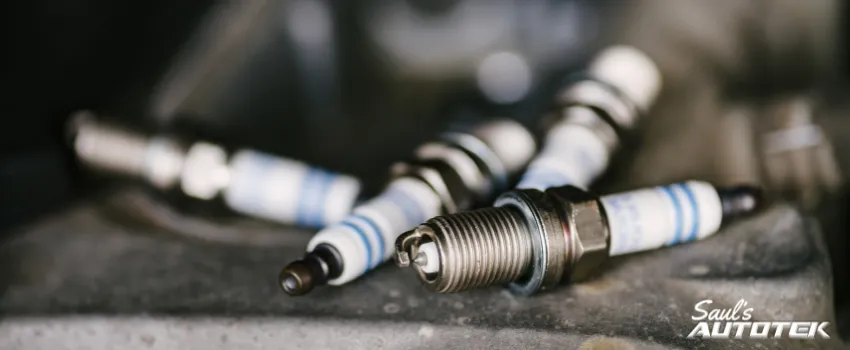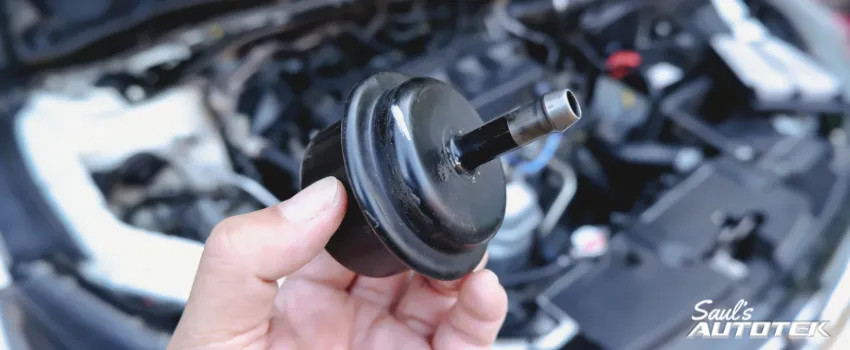Hi there. I’m Saul Reisman here at Saul’s Automotive, and today we are going to talk a little bit about how much we care about your safety in Denver.
One of the most important steering components in your vehicle is the rack and pinion, the center gear, almost five feet wide, that physically pivots your vehicle side to side when you turn that steering wheel. Five feet in front of you at the bottom of that steering wheel, at the end of that column is a small rotational gear. The only thing that physically drives the vehicle side to side is that worm gear pushing against what we call a rack or a tooth gear moving across side to side. That allows your rotational steering input to translate into lateral motion.
In the case of what we see here at Saul’s Automotive, Denver’s roads are very abusive to motor vehicles, and we see many, many vehicles come in and get rack and pinion repairs and replacements. Commonplace here for us. One thing we do not often see is one come in failed under warranty. We’ve installed over a thousand rack and pinions here at Saul’s Automotive. Recently, we had three failures come back in with the same component failures they left with less than a year later.
Not only do we offer a lifetime guarantee parts and labor on these parts hands down, nation-wide, no questions asked, but we take a very personal, vested interest in your safety. We were very concerned to have not one but three failures all come in from the same time frame. We were able to brand-sourced match and find that all three rack and pinions came from the same manufacturer and were manufactured in the same facility during the same week. So, we called that manufacturer and we ordered one rack and pinion directly from them from that same production set, so that we could take it apart ourselves and see what was truly going on.
Now, not only do we no longer use that supplier for the lack of consistency, but we wanted to know exactly what might be going on with their components. So today we are going to show you something you are never going to ’see otherwise. We’re gonna show you the inside of a rack and pinion, how it actually works, how it directly affects your safety and why you should be concerned about producing and purchasing after-market parts for these types of problems.
So today we’re gonna take a look at something that you’re never gonna get to see otherwise. We are going to look inside a rack and pinion and show you directly how it affects your safety, the longevity of your vehicle and how the quality of the product being installed on your vehicle truly makes a major difference in your safety.
So here we have the rack and pinion assembly that we removed from the vehicle. There was fluid leaking out both ends through the boot, as if both external seals at the end of the rack had failed. We were very concerned when we see this type of failure with no external impact, so with the source producing us another of the exact same rack from the same production setting, we took it apart to see exactly what was goin’ on.
First and foremost, on the end of the rack itself, if we break off these boots and seals, we can actually see that there’s a rod here that pushes in and out of this assembly. You’ll notice that this is knurled and has six sides and that this flat rod end also has a tapered side. This is so a wrench can be sat on the rack and a wrench used to tighten the rod end. While this does come with a Teflon seal and an internal O-ring seal, we typically find leaks from constant abuse or constant road abuse from these portions of the rack and pinion.
When we took this rack apart, we pulled both ends, and we found nothing beyond the ordinary. A little grease, a little lubrication, but no leaks. So we went a little step further, and we actually broke this in half. As you see here, the rack mechanism assembled and this is where you turn your steering wheel to input the lateral motion of this rack. We wanted to show you exactly how this works and why this is important, so we took this guy apart and physically broke the internal mechanism.
When you turn the steering wheel, you’re rotating this gear out the bottom. An important thing to see here is that this gear itself only has eight teeth for 360 degrees of rotation. What that translates to is if one tooth has slack because a tooth has become chipped or damaged or that there is play between two teeth in the rack gear itself, that can make almost a 30 to 40 degree play in your steering wheel, well beyond what we would consider safe.
Now, this rotational design, when we think of gears, we think of a bicycle chain. Something that has a chain wrapped around the gear and is able to pull directly against it. That’s not the case of a rack and pinion. Inside the rack itself, where this gear drives, we have a straight edge with teeth across it. You’ll notice it’s only on one side. That literally means that this component must be tight as humanly possible against that rack in order to maintain the tightness of the steering. Over time, the bearing in the mechanism goes bad, allows this rack pivot point to move further away from the actual rack gear itself and provide a loose feel in the steering.
While this can often lead to not only the flat spot in the steering like grandpa’s old truck may have, this is a very difficult-to-diagnose condition. Externally, a mechanic could shake down every component of the steering and never find this problem. The only way to find this problem is by having three technicians, one on each rod end with their fingers on the rods and one in the vehicle turning the wheel side to side to measure the gear play and lash and see how big that gap is in these gears.
Now, one component we’re really gonna look at here is this ball bearing. In this ball bearing, there’s a total of 10 steel balls around the perimeter that allow this rotation. Eventually, this bearing gets loose, the grease escapes from it and allows this shaft to make that distance between itself and the rack. This is why these two cooler lines come across the rack to it, so that oil can flow across this bearing at all times. If this bearing were to fail completely and break, this pin would become dislodged and the vehicle would literally loose the ability to steer, resulting in the steering wheel spinning in place and a vehicle going unpredictably down the road.
We truly take your safety as our first priority here, so when we found out that there was a defect problem with three racks, we took these apart, we figured out what the issue was. We now know that there’s a problem with these bearings, and we’re working with the manufacturer to get it addressed. We’ve also notified the four other owners of vehicles that have had these in for service at other local repair shops that we’ve seen on the road because we made note of them when they came into our shop with the same part numbers on their vehicles. We’ve notified those owners as well so that they can get this corrected completely free of charge on their motor vehicles.
Now, when you hear about the federal government issuing a warranty or a recall for a manufacturer, it’s because a few hundred thousand people had a problem, a couple thousand complained and, finally, that squeaky wheel got the oil and forced a manufacturer to recoup their loss and attempt to right the wrong. Here at Saul’s Automotive, we are so concerned with your safety that we do this every day on our own accord. We will gladly disassemble and pull apart each and every component that comes out of your vehicle to figure out how it failed, what caused it, how to better improve it and ensure that it never happens again.
If you have any concerns about your vehicle’s steering in any way, shape or form, whether it be laterally, rotationally or simply just greasin’ a few bearings, please give us a call here at Saul’s Automotive. We can be reached 365 days a year at 303-919-7769.
Schedule Your FREE diagnostic Subaru Outback Auto Repair Upkeep and Repair Appointment
Check out Our Reviews On Yelp! And Leave A Great One For Us!
Join Our Conversation on Facebook
Explore Our Exceptional Denver Auto Repair Services
- Brake Repair Service
- Suspension Repair
- Steering Repair
- Engine Repair
- Automotive Air Conditioning and Heating Repair





